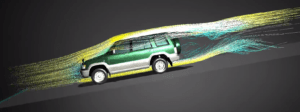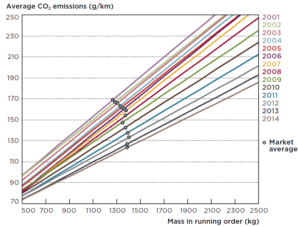Posted on: 19th August 2016 by Kyle Smith
Discussions about lightweighting seem to be very topical at the moment. The car makers are under pressure to reduce emissions in order to meet global CO2 regulations in time to avoid severe financial penalties.
One of the most effective ways to cut a vehicle’s emissions is by reducing its weight (mass). In this blog post I’m going to explain the underlying physics for why this is the case.
To understand vehicle fuel consumption and the impact of lightweighting, we need to understand how energy is dissipated as we drive the vehicle. The overall fuel consumption is the sum of many different types of energy loss.
Inefficient conversion of chemical energy
The inefficient conversion of chemical energy (from the fuel) to mechanical energy leads to a significant energy loss. There are also transmission losses as power is transmitted to the wheels. For a petrol engine this conversion efficiency can be as low as 25%. The balance of the wasted energy occurs mainly as heat in the engine, coolant and transmission.
Let’s put this loss to one side and consider the impact of the size and mass of the vehicle as we drive.

Aerodynamic drag
Aerodynamic drag represents a relatively large energy loss at higher speeds. This comes from the energy required to cause a mass of air to move around the vehicle and swirl about behind it with a speed similar to that of the vehicle. The vehicle energy loss is approximately proportional to the speed of the vehicle squared, the cross-section area of the vehicle and the aerodynamic drag factor, Cd.
At higher speeds this loss becomes very large because of the speed squared relationship. If there is market demand for certain shapes and sizes of vehicle there is not much we can do about this loss. However, we can reduce the drag factor by making the vehicle more streamlined so it creates less turbulent air behind it.
Acceleration and braking
When we accelerate we consume fuel to increase the kinetic energy of the vehicle. This energy is directly proportional to the mass of the vehicle. Braking reduces the vehicle speed, and kinetic energy is lost through heating up of the vehicle braking system. This assumes the vehicle does not have regenerative braking. Braking results in significant energy losses if the distance between the acceleration and braking phases is short.
This pattern of driving is of course typical of city driving. Speeds are also low and so the energy loss due to braking can be much greater than the aerodynamic drag loss.
Driving up and down hills

Up to this point we have assumed we are driving on a flat terrain. In the real world we drive up and down hills. When driving up a hill we use extra fuel to counteract the force of gravity and to increase the potential energy of the vehicle. This extra energy is directly proportional to the mass of the vehicle.
When we drive down a hill we can convert this extra potential energy to kinetic energy. Consequently, we use less fuel to maintain our vehicle speed. However, as with city driving, as soon as we use the brakes to reduce or maintain our speed down the hill then we are losing the energy. For this reason, the downhill sections of our journey do not necessarily compensate for the uphill sections. There is a net loss of energy and overall extra fuel consumption proportional to vehicle mass.
Rolling resistance
One final relatively small energy loss is to counteract rolling resistance. This includes losses due to friction between the tyre and the road, deformation of the tyres and energy losses in the wheel bearings. This loss is proportional to the mass of the vehicle and is independent of speed. Rolling resistance is approximately equivalent to perpetually driving up a 1 in 100 hill.
Clearly, reducing vehicle mass directly reduces the braking and rolling resistance energy losses and improves fuel consumption. For example, a 10% reduction in mass through the use of aluminium in cars instead of steel, can result in a 7% reduction in overall fuel consumption.
Increased vehicle size

In Europe there is a trend towards increased vehicle size. An example of this is the emergence of the popular SUV. This means vehicles are becoming taller with increased frontal area. As a result, the aerodynamic drag losses are increasing.
If we assume the apparent density of a vehicle remains roughly constant with size, then a larger vehicle will also be a heavier vehicle. This will increase the energy losses to the braking system during city driving. It will also increase the energy required to counteract the increased rolling resistance.
Market trends are increasing the pressure that is already present to reduce vehicle emissions. The strategies employed to date include reducing vehicle mass using lightweighting technology, improving the efficiency of powertrains and introducing new technologies such as regenerative braking.
Aluminium as a lightweighting material

As demonstrated so effectively by companies such as Jaguar Land Rover, increased aluminium usage in vehicle structures is a proven lightweighting technology.
Using predominantly one type of lightweighting material (instead of a multi-material approach) also simplifies the task of recycling end-of-life vehicles. This is another reason why there should be increased use of aluminium as a lightweighting material.
In my opinion, if something moves we should make it from lightweight materials such as aluminium. If it doesn’t move and it needs to support very large loads, such as a skyscraper or a bridge, then we should continue to make it from steel.
Innoval and lightweighting
I’ll finish with a final word on how, as a team of aluminium experts, we’re involved with vehicle lightweighting.
Innoval has been providing experience-led technical support to the automotive industry for decades. Our team has contributed to the development and industrialisation of much of the automotive sheet technology in use today. We’ve worked with the OEMs as well as sheet, casting and extrusion suppliers on automotive lightweighting technology.
Read more about how we support aluminium lightweighting projects here.
We’ve also been involved in many cutting-edge projects to increase the use of recycled aluminium. One such project is the very successful REALCAR project.
This blog post was originally written by Dr Tom Farley who has now left the company. Please contact Kyle Smith if you have any questions.



